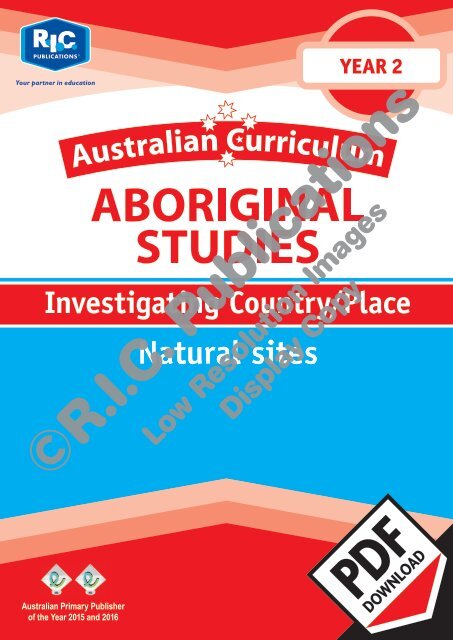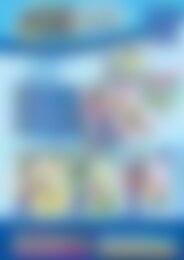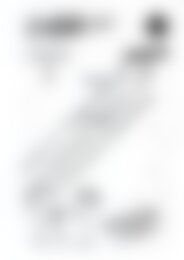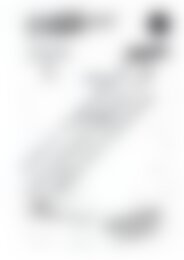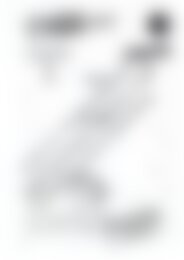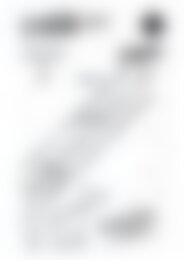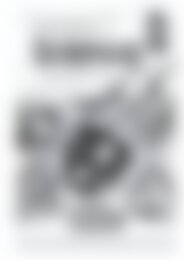20432_AC_Aboriginal_studies_Year_2_Investigating_Country_Place_Natural_sites
You also want an ePaper? Increase the reach of your titles
YUMPU automatically turns print PDFs into web optimized ePapers that Google loves.
Australian Curriculum <strong>Aboriginal</strong> <strong>studies</strong><br />
(<strong>Year</strong>s 1 and 2)<br />
Published by R.I.C. Publications ® 2015<br />
Revised 2018<br />
Copyright © Joanne Crawford 2015<br />
RIC–<strong>20432</strong><br />
Warning: This series may contain the names and images of<br />
<strong>Aboriginal</strong> and Torres Strait Islander people now deceased.<br />
All material identified by is material subject to<br />
copyright under the Copyright Act 1968 (Cth) and is owned<br />
by the Australian Curriculum, Assessment and Reporting<br />
Authority 2015.<br />
For all Australian Curriculum material except<br />
elaborations: This is an extract from the Australian<br />
Curriculum.<br />
Elaborations: This may be a modified extract from the<br />
Australian Curriculum and may include the work of other<br />
authors.<br />
Disclaimer: <strong>AC</strong>ARA neither endorses nor verifies the<br />
accuracy of the information provided and accepts no<br />
responsibility for incomplete or inaccurate information. In<br />
particular, <strong>AC</strong>ARA does not endorse or verify that:<br />
• The content descriptions are solely for a particular year<br />
and subject;<br />
• All the content descriptions for that year and subject<br />
have been used; and<br />
• The author’s material aligns with the Australian<br />
Curriculum content descriptions for the relevant year<br />
and subject.<br />
Copyright Notice<br />
A number of pages in this book are worksheets. The<br />
publisher licenses the individual teacher who purchased<br />
this book to photocopy these pages to hand out to<br />
students in their own classes.<br />
Except as allowed under the Copyright Act 1968, any other<br />
use (including digital and online uses and the creation of<br />
overhead transparencies or posters) or any use by or for<br />
other people (including by or for other teachers, students<br />
or institutions) is prohibited. If you want a licence to do<br />
anything outside the scope of the BLM licence above,<br />
please contact the Publisher.<br />
This information is provided to clarify the limits of this<br />
licence and its interaction with the Copyright Act.<br />
For your added protection in the case of copyright<br />
inspection, please complete the form below. Retain this<br />
form, the complete original document and the invoice or<br />
receipt as proof of purchase.<br />
Name of Purchaser:<br />
Date of Purchase:<br />
Supplier:<br />
School Order# (if applicable):<br />
Signature of Purchaser:<br />
You can find the unaltered and most up to date version of this<br />
material at http://www.australiancurriculum.edu.au/<br />
This material is reproduced with the permission of <strong>AC</strong>ARA.<br />
Internet web<strong>sites</strong><br />
In some cases, web<strong>sites</strong> or specific URLs may be recommended. While these are checked and rechecked at the time of publication,<br />
the publisher has no control over any subsequent changes which may be made to webpages. It is strongly recommended that the class<br />
teacher checks all URLs before allowing students to access them.<br />
View all pages online<br />
PO Box 332 Greenwood Western Australia 6924<br />
Website: www.ricpublications.com.au<br />
Email: mail@ricgroup.com.au
Foreword<br />
Australian Curriculum <strong>Aboriginal</strong> <strong>studies</strong> (<strong>Year</strong>s 1 and 2) is one of a four-book series<br />
designed to complement the teaching of <strong>Aboriginal</strong> <strong>studies</strong> in the national curriculum. Each<br />
unit of work is designed to recognise and emphasise the importance of <strong>Aboriginal</strong> culture<br />
within Australia.<br />
Titles in this series are:<br />
• Australian Curriculum <strong>Aboriginal</strong> <strong>studies</strong> (Foundation)<br />
• Australian Curriculum <strong>Aboriginal</strong> <strong>studies</strong> (<strong>Year</strong>s 1 and 2)<br />
• Australian Curriculum <strong>Aboriginal</strong> <strong>studies</strong> (<strong>Year</strong>s 3 and 4)<br />
• Australian Curriculum <strong>Aboriginal</strong> <strong>studies</strong> (<strong>Year</strong>s 5 and 6)<br />
Contents<br />
Teachers notes..........................................ii-iii<br />
Australian Curriculum links......................iv-vii<br />
Additional resources...............................viii-ix<br />
<strong>Investigating</strong> <strong>Country</strong>/<strong>Place</strong>................ 2–37<br />
<strong>Place</strong>names.............................................. 2–5<br />
<strong>Aboriginal</strong> and Torres Strait<br />
Islander placenames................................ 6–9<br />
Where people live................................. 10–13<br />
Landforms and features....................... 14–17<br />
Dreamtime stories................................ 18–21<br />
Local features....................................... 22–25<br />
Historical <strong>sites</strong>...................................... 26–29<br />
<strong>Natural</strong> <strong>sites</strong>......................................... 30–33<br />
<strong>Aboriginal</strong> <strong>sites</strong>..................................... 34–37<br />
<strong>Investigating</strong> culture......................... 38–61<br />
The Arts – Music................................. 38–41<br />
The Arts – Dance and drama.............. 42–45<br />
The Arts – Visual arts.......................... 46–49<br />
Weather patterns................................ 50–53<br />
<strong>Aboriginal</strong> seasonal calendar............. 54–57<br />
Weather data...................................... 58–61<br />
<strong>Investigating</strong> people......................... 62–81<br />
Connection to <strong>Country</strong>....................... 62–65<br />
Many connections.............................. 66–69<br />
Family structures................................ 70–73<br />
Roles of family members.................... 74–77<br />
<strong>Aboriginal</strong> families.............................. 78–81<br />
Answers............................................. 82–86<br />
Acknowledgements<br />
Special thanks to the following people who made a contribution this book.<br />
• Mr Geoff Drage<br />
• Elaine Morgan<br />
R.I.C. Publications ® www.ricpublications.com.au Australian Curriculum <strong>Aboriginal</strong> <strong>studies</strong> (<strong>Year</strong>s 1 and 2) i
Teachers notes<br />
How to use this book<br />
The book is divided into three sections—<strong>Investigating</strong> <strong>Country</strong>/<strong>Place</strong>, <strong>Investigating</strong> culture and<br />
<strong>Investigating</strong> people.<br />
Each section has a number of units which link directly to Australian Curriculum knowledge and<br />
understanding content descriptions of the Geography, Science, History and The Arts learning areas.<br />
Links to other curriculum areas are included.<br />
Features of the book<br />
• An overview of Australian Curriculum skills relating to each unit of work<br />
• Answers or possible answers have been provided for student activities. Some activities may be<br />
open-ended and require further research, resulting in a variety of possible answers. These are<br />
marked as ‘Teacher check’. Answers can be found at the back of the book on pages 82–86.<br />
Unit format<br />
Each unit of work follows a similar four-page format, comprising a teachers page followed by three<br />
student pages. The student pages relate to some aspect of the content description at the top of the<br />
teachers page.<br />
Teachers page<br />
The first page in each four-page unit is a teachers page, which includes the following information:<br />
The title of the section<br />
The content description, code<br />
and Australian Curriculum learning<br />
area (History/Geography/Science or<br />
The Arts) which is covered by the<br />
four-page unit<br />
An elaboration explaining what the<br />
students will be assisted to learn<br />
by completing the activities in the<br />
four-page unit<br />
Key questions relating to the focus<br />
of the unit<br />
Skills and inquiry that students<br />
will utilise to complete the activities<br />
in the unit<br />
The title of the unit<br />
Teacher notes which provide<br />
suggestions for using the resources<br />
and completing the activities on the<br />
following three student pages<br />
Background information provides<br />
additional notes to assist the<br />
teacher to understand and help<br />
students understand the unit<br />
An additional activity extends<br />
student learning beyond the scope of<br />
the student pages<br />
The overall concept of the unit<br />
Resources to support teaching and<br />
learning activities within the unit<br />
ii Australian Curriculum <strong>Aboriginal</strong> <strong>studies</strong> (<strong>Year</strong>s 1 and 2) R.I.C. Publications ® www.ricpublications.com.au
Student pages<br />
Teachers notes<br />
The three student pages follow a similar format and include the following information:<br />
The title of the unit<br />
A number indicates one of the<br />
three student pages in the unit<br />
A text or activity with<br />
instructions for completing<br />
Appropriate artwork aids<br />
understanding of the text<br />
R.I.C. Publications ® www.ricpublications.com.au Australian Curriculum <strong>Aboriginal</strong> <strong>studies</strong> (<strong>Year</strong>s 1 and 2) iii
<strong>Investigating</strong> <strong>Country</strong>/<strong>Place</strong><br />
The importance today of a historical site of cultural or spiritual significance in the local area, and why it<br />
should be preserved (<strong>AC</strong>HASSK045) <strong>Year</strong> 2 – History<br />
<strong>Natural</strong> <strong>sites</strong><br />
Elaboration<br />
Understanding that there are many <strong>sites</strong>, places and<br />
landscapes in Australia that are of significance to the<br />
identity of our nation<br />
Key questions<br />
• What is considered to be a natural site?<br />
• Why is it important to preserve natural <strong>sites</strong>?<br />
Skills and inquiry<br />
• Pose questions about past and present objects,<br />
people, places and events (<strong>AC</strong>HASSI034)<br />
• Compare objects from the past with those from the<br />
present and consider how places have changed over<br />
time (<strong>AC</strong>HASSI039)<br />
• Present narratives, information and findings in oral,<br />
graphic and written forms using simple terms to<br />
denote the passing of time and to describe direction<br />
and location (<strong>AC</strong>HASSI043)<br />
Concepts<br />
• History<br />
• Sacred places<br />
• Local history<br />
• Culture<br />
Resources<br />
• (an informative clip<br />
about the Great Barrier Reef)<br />
• (a clip about Shark<br />
Bay)<br />
• (a clip about Kakadu<br />
National Park)<br />
Teacher information<br />
Teachers notes<br />
• Display some internet images of selected historical<br />
<strong>sites</strong> such as Kakadu and The Great Barrier Reef.<br />
• Discuss historical <strong>sites</strong> with the students and why<br />
they are important to Australians.<br />
• Read through each information page with the<br />
students and discuss. Display images of the places<br />
for students to view, and give them the opportunity to<br />
talk among themselves about each image.<br />
• View to find other places that<br />
are historical <strong>sites</strong>.<br />
Background information<br />
• There are a lot of places in Australia which have<br />
some heritage significance. They include natural,<br />
historic and Indigenous places.<br />
• The Australian Heritage Council assesses a site<br />
based on set criteria. These can be viewed at .<br />
• Australia has various protected <strong>sites</strong> on the World<br />
Heritage listing. There are many places on the<br />
national list because of their cultural and historical<br />
significance.<br />
Additional activity<br />
• Ask the students to make a brochure about their<br />
community. They should include any information<br />
on <strong>sites</strong> within the area. Give the students the<br />
opportunity to take photos of these <strong>sites</strong>.<br />
30 Australian Curriculum <strong>Aboriginal</strong> <strong>studies</strong> (<strong>Year</strong>s 1 and 2) R.I.C. Publications ® www.ricpublications.com.au
<strong>Natural</strong> <strong>sites</strong> – 1<br />
The Great Barrier Reef is one of Australia’s most<br />
amazing landmarks. It is the largest coral reef in the<br />
world and contains much marine life, reef systems,<br />
coral cays and beautiful islands and beaches. It was<br />
listed as a World Heritage site in 1981 and is one of the seven wonders of<br />
the natural world. The Great Barrier Reef is the only living thing that can be<br />
seen from space and it is bigger than the Great Wall of China.<br />
Use the information in and from the text to<br />
complete the answers.<br />
Circle the correct answers.<br />
1. The Great Barrier Reef is described as being:<br />
(a) an underwater city (b) a small world (c) a small planet<br />
2. The number of different types of habitats there is:<br />
(a) 40 (b) 70 (c) 100<br />
3. The Great Barrier Reef was put on the World Heritage list in:<br />
(a) 1961 (b) 1971 (c) 1981<br />
4. How old do scientists think the Great Barrier Reef is?<br />
(a) 15 000 years (b) 20 000 years (c) 10 000 years<br />
5. Draw a picture of what you think the Great Barrier Reef looks like.<br />
R.I.C. Publications ® www.ricpublications.com.au Australian Curriculum <strong>Aboriginal</strong> <strong>studies</strong> (<strong>Year</strong>s 1 and 2) 31
<strong>Natural</strong> <strong>sites</strong> – 2<br />
Kakadu National Park<br />
is situated in the north<br />
of Australia and is a World Heritage site.<br />
Kakadu is unique because of the amazing collection of birds, plants and<br />
animals that live there. It is also home to the large saltwater crocodile. It is<br />
on the World Heritage list because of its cultural and natural importance.<br />
This area is important to <strong>Aboriginal</strong> people. It has many <strong>sites</strong> containing<br />
art which shows how the Indigenous people have lived in this area for<br />
thousands of years.<br />
View and complete the activities below.<br />
Circle the correct answers.<br />
1. Where is Kakadu National Park?<br />
(a) Western Australia<br />
(b) Northern Territory<br />
2. For most of the year, Kakadu National Park is ...<br />
(a) dry<br />
(b) wet<br />
3. Kakadu National Park is Australia’s largest national park.<br />
(a)<br />
True<br />
(b)<br />
False<br />
4. Kakadu National Park was once under the sea.<br />
(a)<br />
True<br />
(b)<br />
False<br />
5. Draw a picture of what you think Kakadu National Park looks like.<br />
32 Australian Curriculum <strong>Aboriginal</strong> <strong>studies</strong> (<strong>Year</strong>s 1 and 2) R.I.C. Publications ® www.ricpublications.com.au
<strong>Natural</strong> <strong>sites</strong> – 3<br />
Shark Bay, in Western Australia, is on the World Heritage list because of<br />
its natural heritage value. It covers a large area along the coast of Western<br />
Australia and has an abundance of plants and animals. Some species are<br />
endangered and cannot be found anywhere else on Earth. Sea grass grows<br />
in this area and provides many species with a regular source of food. Shark<br />
Bay also has stromatolites (living fossils) growing there. This is another<br />
reason why this is a very special place in the world.<br />
View and complete the activities below.<br />
Circle the correct answers.<br />
1. Shark Bay is a World Heritage site.<br />
(a) True<br />
(b) False<br />
2. In which state is Shark Bay?<br />
(a) South Australia<br />
3. Shell beach is made up of:<br />
(a) sand<br />
(b) shells (c) stones<br />
(b) Western Australia<br />
4. What is the name of the famous explorer who came to Shark Bay?<br />
5. Draw a picture of what you think Shark Bay may look like.<br />
R.I.C. Publications ® www.ricpublications.com.au Australian Curriculum <strong>Aboriginal</strong> <strong>studies</strong> (<strong>Year</strong>s 1 and 2) 33
<strong>Investigating</strong> <strong>Country</strong>/<strong>Place</strong><br />
<strong>Natural</strong> <strong>sites</strong><br />
Page 31<br />
1. an underwater city<br />
2. 70<br />
Page 32<br />
3. 1981<br />
4. 20 000<br />
5. Teacher check<br />
1. Northern Territory<br />
2. wet<br />
3. True<br />
4. True<br />
Page 33<br />
5. Teacher check<br />
1. True<br />
2. Western Australia<br />
3. shells<br />
4. Dirk Hartog<br />
5. Teacher check<br />
Answers<br />
R.I.C. Publications ® www.ricpublications.com.au Australian Curriculum <strong>Aboriginal</strong> <strong>studies</strong> (<strong>Year</strong>s 1 and 2) 83


